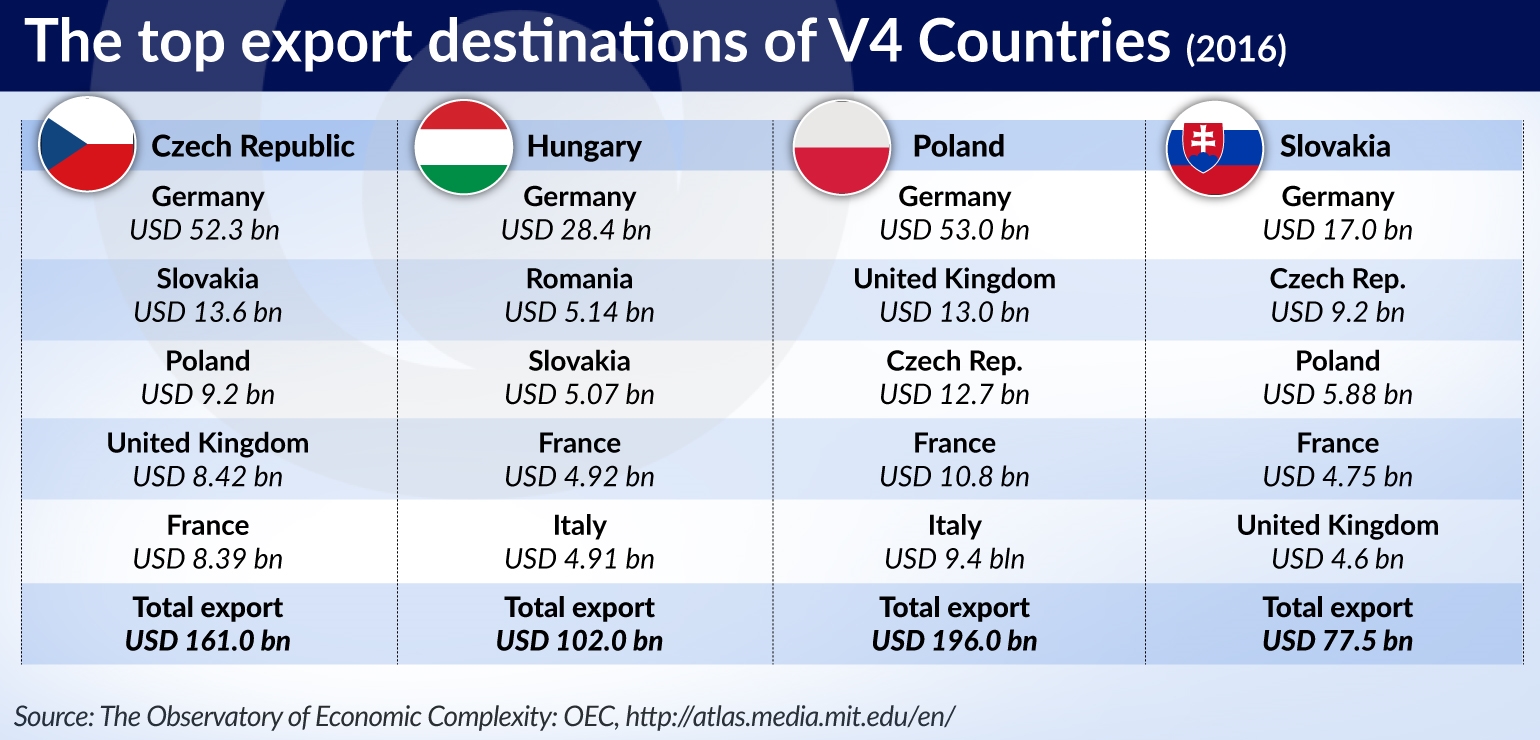Tydzień w gospodarce
Category: Trendy gospodarcze

Although the salaries in the V4 countries are perceivably lower than in Western Europe, all the members of the group are considered highly developed when the Human Development Index (HDI) is considered. In fact, in the recent years the economies of the V4 countries could generally be considered successful, with their stable GDP growth and very low unemployment rates.
It can be said that Poland and the Czech Republic in particular are important exporters of some goods, and not only on a European scale, which is very positively affecting their economies. At the same time, it is worthwhile to stress that most of the top export partners of the V4 are the largest countries of the Western Europe, with their huge markets, particularly Germany, France, the United Kingdom, and Italy. Germany is undoubtedly the most important trade partner of all the V4 four countries. Between 22 per cent and 33 per cent of all exports of those countries is sold on the German market. For all the countries France is also amongst the top five of export recipients.
However such a situation seems to be obvious: since Germany is the largest economy in the EU and German companies are the largest investors in the V4 countries, serious damages can be caused if any economic crisis should occur in Germany or if soured political relations with Berlin adversely influence the economy. What is more, the lists of the V4’s exports partners appear to be very similar.
Among the top 10 export destinations of Czech Republic, Slovakia, and Hungary all the listed countries belong to the EU, and among the top 10 export destinations of Poland, only one does not belong to the EU: Russia (7th place). Only a minor portion of the V4 countries’ exports go to such countries as China, Turkey, Japan, South Korea, or India. For instance, China is the destination of only 0.97 per cent of Poland’s exports, whereas it is 1.2 per cent in case of the Czech Republic, 1.6 per cent in case of Slovakia, and 2.2 per cent in case of Hungary. If the One Belt One Road Initiative eventually will be fully implemented, there is a chance to increase the exports to Asian countries, primarily to China. It can enable diversification of export destinations of the V4 countries.
The gross exports of the Czech Republic in 2016 were estimated at USD161bn. The primary export destinations according to 2016 surveys were Germany (USD52.3bn – 33.0 per cent of export), followed by Slovakia (USD13.6bn – 8.4 per cent), Poland (USD9.2bn – 5.7 per cent), the United Kingdom (USD8.42bn – 5.2 per cent), France (USD8.39bn – 5.2 per cent), Austria (USD6.8bn – 4.2 per cent), Italy (USD6.79bn – 4.2 per cent), Hungary (USD4.66bn – 2.9 per cent), the Netherlands (USD4.61bn – 2.9 per cent), and Spain (USD4.56bn – 2.8 per cent).
The primary goods exported from the Czech Republic are cars (USD18.7bn – 12 per cent), followed by vehicle parts (USD13.5bn – 8.4 per cent), computers (USD8.69bn – 5.4 per cent), chairs (USD2.71bn – 1.7 per cent), and insulated wire (2.61bn – 1.6 per cent). In 2016, the Czech Republic had a net trade balance of USD22.5bn. It is noteworthy to emphasize that the Czech Republic is the EU’s third largest exporter of vehicle parts, just after Germany and France, and before Italy and Poland. Furthermore, the Czech Republic is the 5th country in the EU in terms of exporting cars, following Germany, the United Kingdom, Spain, and Belgium (and itself followed by France, Slovakia, and Italy), as well as the 3rd country in the EU in terms of exporting computers, the 4th exporter of chairs, and the 4th largest exporter of insulated wire. This may also be one of the reasons why the Czech Republic has the lowest unemployment rate amongst the EU member states (2.9 per cent as of August 2017).
Not surprisingly, Poland has the largest gross exports values amongst the V4 countries: it was estimated at USD196bn in 2016. However, with a population of about 38 million, it is also the most populous country of the V4, making the exports’ value per capita less impressive than that of the Czech Republic. The main export destination in 2016 was obviously Germany (USD53bn – 27.0 per cent), which was followed by the United Kingdom (USD13bn – 6.6 per cent), the Czech Republic (USD12.7bn – 6.5 per cent), France (USD10.8bn – 5.5 per cent), Italy (USD9.42bn – 4.8 per cent), the Netherlands (USD8.67B – 4.4 per cent), Russia (USD5.79bn – 3.0 per cent), Sweden (USD5.65bn – 2.9 per cent), Spain (USD5.43bn – 2.8 per cent), and Hungary (USD5.18bn – 2.6 per cent).
The most important goods exported by Poland in 2016 were vehicle parts (USD11.2bn – 5.7 per cent), followed by cars (USD7.59bn – 3.9 per cent), chairs (USD5.46bn – 2.8 per cent), computers (USD4.0bn – 2.0 per cent), and other furniture excluding chairs (USD3.98bn – 2.0 per cent). In 2016, Poland had a net export of USD9.6bn. It is worthwhile to emphasize that Poland is the European Union’s primary exporter of chairs (before Germany, Italy, Czech Republic, and Romania) and the 3rd exporter of chairs in the world (after China and Mexico). Furthermore, Poland is the 4th country in the world in terms of exporting other furniture (i.e. excluding chairs), after China, Germany, and Italy. Poland is also the EU’s 5th exporter of computers and its 5th exporter of insulated wire. Poland can also be considered one of the world’s most important exporters of foodstuffs and agricultural produce. For example, Poland is the world’s 4th largest exporter of poultry meat, 5th largest exporter of milk as well as of eggs, 6th largest exporter of processed fish, 7th largest exporter of bovine meat and chocolate, and the 8th largest exporter of apples and baked goods.
The value of gross exports of Hungary in 2016 was estimated at USD102bn, so remarkably lower than that of the Czech Republic, a country with a similar population (10.5 million in Czech Rep., 9.8 million in Hungary). Unsurprisingly, the primary export destination of Hungary in 2016 was Germany (USD28.4bn – 28 per cent), followed by Romania (USD5.14bn – 5.0 per cent), Slovakia (USD5.07bn – 4.9 per cent), France (USD4.92bn – 4.8 per cent), and Italy (USD4.91bn – 4.8 per cent). Other countries in Hungary’s top 10 export destinations were: Austria (USD4.89bn – 4.8 per cent), the Czech Republic (USD4.27bn – 4.1 per cent), Poland (USD4.2bn – 4.1 per cent), the United Kingdom (USD4.03bn – 3.9 per cent), and the Netherlands (USD3.25bn – 3,2 per cent). Hungarian exports in 2016 consisted primarily of cars (USD11bn – 11 per cent), followed by vehicle parts (USD5.92bn – 5.8 per cent), spark-ignition engines (USD3.53bn – 3.4 per cent), packaged medicaments (USD3.27bn – 3.2 per cent), and combustion engines (USD2.82bn – 2.7 per cent). In 2016, Hungary had a net trade balance of USD11.5bn.
Slovakia, as the least populous country amongst V4, has the lowest gross exports, which in 2016 were estimated at USD77.5bn. Slovakia’s top export destinations were Germany (USD17bn – 22.0 per cent), followed by the Czech Republic (USD9.2bn – 12 per cent), Poland (USD5,88bn – 7.6 per cent), France (USD4.75bn – 6.1 per cent), and the United Kingdom (USD4.6bn – 5.9 per cent). Amongst Slovakia’s other top 10 export destinations were also: Austria (USD4.44bn – 5.7 per cent), Hungary (USD4.32bn – 5.6 per cent), Italy (USD3.74bn – 4.8 per cent), Spain (USD2.3bn – 3 per cent), and the Netherlands (USD2.24bn – 2.9 per cent). Slovakia’s most important export goods were cars (USD15.5bn – 20 per cent), followed by video displays (USD6.07bn – 7.8 per cent), vehicle parts (USD4.44bn – 5.7 per cent), broadcasting equipment (USD3.54bn – 4.6 per cent), and rubber tires (USD1.75bn – 2.3 per cent). In 2016, Slovakia had a net trade balance of USD10.2bn.
In conclusion, the most important export goods of the V4 countries are vehicle parts, cars, furniture, computers and other electronic equipment. The V4, as countries located in Central Europe, which have relatively low labor costs, particularly attract the attention of investors in these sectors. Altogether, machinery, as well as vehicles and vehicle parts, make up 62 per cent of Slovak, 58 per cent of Czech, 57 per cent of Hungarian, and 39 per cent of Polish exports.
Poland has clearly the most diversified exports, i.a. thanks to a well-developed and sizeable foodstuffs and agricultural produce sector, as well as the metallurgical industry sector and a very large output of furniture. At the same time, it is noteworthy to emphasize that large part of the manufactured machinery, as well as vehicles and vehicle parts, exported by the V4 countries are produced by foreign companies, whereas local investors do not play a significant role, especially in the cases of Slovakia and Hungary.
Michał Kowalczyk is a PhD student at the History and Social Science Department of the Cardinal Stefan Wyszyński University in Warsaw. He specializes in Hungarian and Central European politics.
